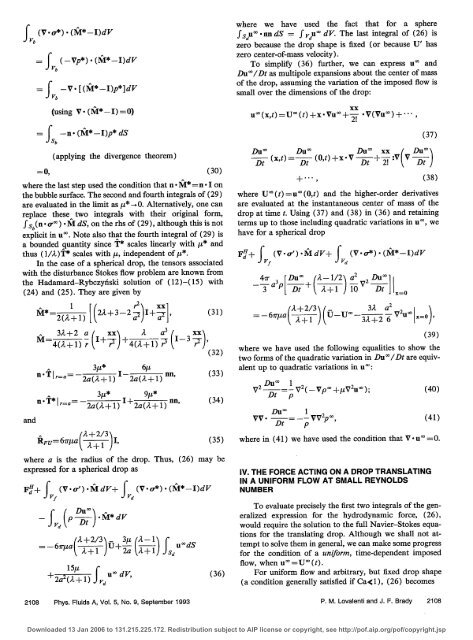The force on a bubble, drop, or particle in arbitrary time-dependent ...
The force on a bubble, drop, or particle in arbitrary time-dependent ...
The force on a bubble, drop, or particle in arbitrary time-dependent ...
You also want an ePaper? Increase the reach of your titles
YUMPU automatically turns print PDFs into web optimized ePapers that Google loves.
= fV", (-Vp*).- (M*..)dV<br />
= .fVh -V ' [ (1M*-I)p*I]dV<br />
(us<strong>in</strong>g V * (M1* I) =O)<br />
where we have used the fact that f<strong>or</strong> a sphere<br />
fsdu- * nn dS = f VpU dV. <str<strong>on</strong>g>The</str<strong>on</strong>g> last <strong>in</strong>tegral of (26) is<br />
zero because the <strong>drop</strong> shape is fixed (<strong>or</strong> because U' has<br />
zero center-of-mass velocity).<br />
To simplify (36) further, we can express u' and<br />
Du'/Dt as multipole expansi<strong>on</strong>s about the center of mass<br />
of the <strong>drop</strong>, assum<strong>in</strong>g the variati<strong>on</strong> of the imposed flow is<br />
small over the dimensi<strong>on</strong>s of the <strong>drop</strong>:<br />
xx<br />
= fb -n (M*1)p* dS<br />
(apply<strong>in</strong>g the divergence the<strong>or</strong>em)<br />
= 0, (30)<br />
where the last step used the c<strong>on</strong>diti<strong>on</strong> that n - M* =n * I <strong>on</strong><br />
the <strong>bubble</strong> surface. <str<strong>on</strong>g>The</str<strong>on</strong>g> sec<strong>on</strong>d and fourth <strong>in</strong>tegrals of (29)<br />
are evaluated <strong>in</strong> the limit as u -*0. Alternatively, <strong>on</strong>e can<br />
replace these two <strong>in</strong>tegrals with their <strong>or</strong>ig<strong>in</strong>al f<strong>or</strong>m,<br />
f sb(n * oX) * M dS, <strong>on</strong> the rhs of (29), although this is not<br />
explicit <strong>in</strong> up. Note also that the fourth <strong>in</strong>tegral of (29) is<br />
a bounded quantity s<strong>in</strong>ce T* scales l<strong>in</strong>early with jz* and<br />
thus (1/A)T* scales with j,, <strong>in</strong><strong>dependent</strong> of !L*.<br />
In the case of a spherical <strong>drop</strong>, the tens<strong>or</strong>s associated<br />
with the disturbance Stokes flow problem are known from<br />
the Hadamard-Rybczyfiski soluti<strong>on</strong> of (12)-(15) with<br />
(24) and (25). <str<strong>on</strong>g>The</str<strong>on</strong>g>y are given by<br />
I [(r2)I xx],<br />
M 2(A-+- 1) ±3 a' -a (31)<br />
3A -- 2 a Ixx A a 3 I xx)<br />
M4i +1) r I++4(7+1) 7 (32)<br />
n. 3-t* I -2 + 1_ nn, (33)<br />
__ T*|ra=-2(3t1±<br />
2a (/2+ ) I+± 2a(A 9 +l1)<br />
nn, (34)<br />
and<br />
fZFU= 6 lTIita ( A+ 2/3) 35<br />
( A + I<br />
where a is the radius of the <strong>drop</strong>. Thus, (26) may be<br />
expressed f<strong>or</strong> a spherical <strong>drop</strong> as<br />
F,+ fv (v a-'<br />
ti ( Duem) ' * dV<br />
fVd (. Dt).Md<br />
M 1dV+ !;d (V -de) -~* (M-<br />
=-61ua( 2+ I )f 32a (A+1) fSd<br />
)d V<br />
+2a2(,+l) u' dv, (36)<br />
(37)<br />
Dum Dug DuN xx ( \__<br />
Dt (x,t)= Dt (Ot)+x V Dt +2 :VV Dt)<br />
+---, (38)<br />
where U (t)=u=(O,t) and the higher-<strong>or</strong>der derivatives<br />
are evaluated at the <strong>in</strong>stantaneous center of mass of the<br />
<strong>drop</strong> at <strong>time</strong> t. Us<strong>in</strong>g (37) and (38) <strong>in</strong> (36) and reta<strong>in</strong><strong>in</strong>g<br />
terms up to those <strong>in</strong>clud<strong>in</strong>g quadratic variati<strong>on</strong>s <strong>in</strong> u', we<br />
have f<strong>or</strong> a spherical <strong>drop</strong><br />
Fd'+f(V - ') MdV+ (V-t,*) (M* -)dV<br />
4ir 3 [Du /(A-1/2\ a 2 2 DU.<br />
-- a - T- j0 -jt<br />
-3 a3PL Dt A+1 ) 10 Dt It lix=o<br />
A +2/3 _ 32 a 2<br />
(A++1 ')(U U -3,+_2 _6 2xo)<br />
(39)<br />
where we have used the follow<strong>in</strong>g equalities to show the<br />
two f<strong>or</strong>ms of the quadratic variati<strong>on</strong> <strong>in</strong> Du'/Dt are equivalent<br />
up to quadratic variati<strong>on</strong>s <strong>in</strong> up:<br />
Du' 0 1<br />
v 2 .-. =-V 2 (_Vp,+tjV 2 u',);<br />
.Du_ I<br />
VV. -=--VV p"<br />
Dt p<br />
(40)<br />
(41)<br />
where <strong>in</strong> (41) we have used the c<strong>on</strong>diti<strong>on</strong> that V u' =0.<br />
IV. THE FORCE ACTING ON A DROP TRANSLATING<br />
IN A UNIFORM FLOW AT SMALL REYNOLDS<br />
NUMBER<br />
To evaluate precisely the first two <strong>in</strong>tegrals of the generalized<br />
expressi<strong>on</strong> f<strong>or</strong> the hydrodynamic <str<strong>on</strong>g>f<strong>or</strong>ce</str<strong>on</strong>g>, (26),<br />
would require the soluti<strong>on</strong> to the full Navier-Stokes equati<strong>on</strong>s<br />
f<strong>or</strong> the translat<strong>in</strong>g <strong>drop</strong>. Although we shall not attempt<br />
to solve them <strong>in</strong> general, we can make some progress<br />
f<strong>or</strong> the c<strong>on</strong>diti<strong>on</strong> of a unif<strong>or</strong>m, <strong>time</strong>-<strong>dependent</strong> imposed<br />
flow, when u'=U-(t).<br />
F<strong>or</strong> unif<strong>or</strong>m flow and <strong>arbitrary</strong>, but fixed <strong>drop</strong> shape<br />
(a c<strong>on</strong>diti<strong>on</strong> generally satisfied if Cal
















